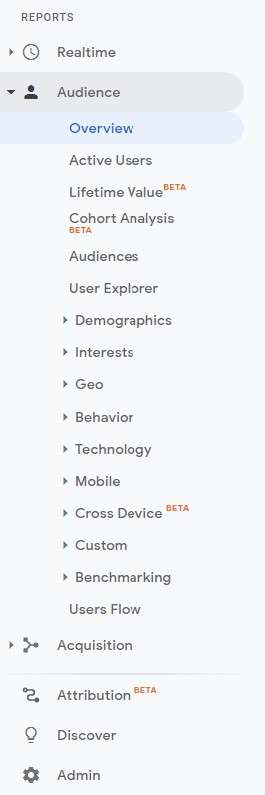How Do You Find Your Audience in Google Analytics?

Analyze Your Users and Drive Conversions in Google Analytics
It’s tempting to make assumptions about your audience and users, but creating a more quantitative, data analysis-infused strategy will help you dig right down into what makes your audiences tick. Then, you can craft engaging content that works by truly understanding your audience and optimizing your online content, social media, and advertising campaigns accordingly. This is a guide to really understanding your target audience.
Google Analytics is a must-have and provides a variety of website and webpage metrics (e.g., time on page, number of sessions) and demographic information (e.g., age, gender, region, interests). This allows you to study behavioral data alongside classic website metrics.
Audience Tab
The ‘Audience’ tab within Google Analytics is a great starting point. You’ll firstly need to take a top-down look at all of your users to see:
- Their country/region/geography
- Their age and gender
- Their interests
If you have a preconceived idea of your audience, you might be surprised either by how diverse or non-diverse it is. For example, you might be marketing women’s beauty products to younger women when your audience is actually much older than you think, or a large part of your audience might be male gift buyers. If the latter is correct, it might be wise to explore content that appeals to male gift buyers than angling everything at a female audience.
In B2B, you might be marketing towards an assumed 40+ demographic of C-suite execs, but Google recently found that some 24% of the non-C-suite making B2B buying decisions, and some 70% of buyers are aged between 18 and 34. So if you discover that your audience is younger than what you assumed, you should explore marketing to that audience. These are examples of assumptions you might make if you don’t truly understand your audience.
The Interests Tab
The ‘Interests’ tab (under the Audience Tab) is particularly interesting and will display what common interests your users have across different categories such as ‘TV and Film Buffs’, ‘Sports Fans,’ ‘Luxury Travelers,’ ‘Beauty and Wellness’ and many other categories.
This information can be combined with demographic data, i.e. age and gender, to create powerful insights into what your audience cares about and enjoys. Then, once you’ve found your strongest affinity categories, crafting blog and social media content to cover that is relatively straightforward.
What insights can be gained from an analysis of your audience?
- Your audiences love film and TV? Explore some viral marketing campaigns that engage them in the latest trends.
- Your audiences love eco-friendly and environmental causes? Then, explore some content that targets that.
- Your audiences love technology? Create content to illustrate your knowledge in that area.
Analyzing New vs Return Visitors
It’s possible to analyze new vs return visitors to discover information about your ‘core audience’ and emerging user group. To do this, modern IT tools for business intelligence like Google Analytics place a cookie in the user’s browser to track what websites that user visits. Note that each user device (mobile, laptop, desktop) is tracked separately.
Frequent Visitors
Those users who return to your site regularly are your frequent visitors.
New Visitors
New users, which also help measure the effectiveness of certain campaigns (e.g. a social media ad campaign), are new visitors that have not visited your site before from that same device.
Most Engaged Visitors
Users visit pages. Those who display low bounce rates (quickly leave a webpage), high pages/session, and high session durations are an indicator of how engaged customers are. Users that visit a lot of pages and remain on a page for an extended period of time and considered your most engaged visitors.
Highest Converting Visitors
The audience that completed specified goals, which can be set up in Add Segment > Conditions > Find your specific goal, are your highest converting visitors.
In an ideal situation, you’ll find a common thread of users that fulfill all of these criteria. This would indicate a very strong group of core users. Identifying your core users helps measure other metrics, such as customer lifetime value (CLV).
Using Segments
Google Analytics Segments allow you to view, measure, and analyze specific user groups. For example, you can segment by age, gender, location, and user type (e.g., new or return visitor).
The segment customization available within Google Analytics is good, but other products such as Segment and mParticle connect customer segment data to marketing automation and engagement tools, as well as recommendations engines, email marketing suites, and many more powerful business tools. These customer data platforms centralize customer and audience data to unlock new business intelligence and marketing automation potential.
Social Media Audience Analysis
As well as analyzing your audience from websites and apps, social media analysis helps reveal insights into those who connect with your brand’s social media content. Most social media platforms have built-in data studios designed for tracking social media metrics.
In Facebook, the ‘People Engaged’ tab provides demographic insights. It’s a similar story on Instagram under the ‘Insights’ tab, which allows you to look at stories, posts, videos, and reels. For Twitter, there is a free tool called FollowerWonk that helps you analyze the interests of your followers. In all of these examples, the goal is practically the same: find common threads or mutual ground to inform your marketing, content, and sales tactics.
Once You Know Your Audience
Studying demographic and customer data, it’s time to take a closer look at your current campaigns:
- Does your content provide for your audience? What can you do better?
- Does branding, logos and other marketing collateral appeal to your core audience?
- The above also applies to product descriptions and even packaging and product branding, does it tally with your audience?
- Can you tweak social media campaigns to appeal to your users’ affinity categories?
- Does your brand voice and messaging appeal to your audience?

Once you start tweaking campaigns for your real audience, it’s a matter of measuring successes/failures. A/B testing is an asset here as it allows you to experiment without making permanent changes. You could also ask a selection of repeat customers for their opinions via surveys or feedback forms.
Find Your Audience in Google Analytics
The better your understanding of your audience, the better you can communicate with them across all channels. Plugging segments into recommendation engines and marketing automation tools would be the next step — this enables you to target the specific user without generalizing.















Leave a Reply